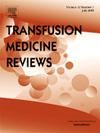Platelet Additive Solutions and Pathogen Reduction Impact on Transfusion Safety, Patient Management and Platelet Supply
IF 2.5
2区 医学
Q2 HEMATOLOGY
引用次数: 0
Abstract
Since 1998, leuko-reduction is used in France for all platelet concentrates (PCs), apheresis-derived (APCs) and pooled whole blood-derived buffy-coats (BCPCs). Platelet additive solutions (PAS), introduced in 2005, accounted for over 80% of the platelet supply from 2011 to 2017. The Intercept pathogen reduction technology (PR), started in a pilot study in 2007, was generalized in 2018. Between 2007 and 2021, the use of BCPCs increased steadily from 23% to 70% of the supply. Objectives: to analyze the impact of these modifications on adverse transfusion reactions (ATRs), patient management and blood transfusion organization. Results: The overall incidence of ATRs /105 PCs is significantly lower with PAS- and PR-PCs as compared to PCs in plasma (PL), with the decreasing hierarchy PL > PAS > PR. PAS- and PR-PCs lead to significantly lower incidences of allergy and alloimmunization to RBC antigens (RC-AI) ATRs. The incidence of bacteria transmission (TTBI) is significantly reduced by 95% with PR-PCs. APC-related ATR incidence is significantly higher than BCPC for allergy (+233%), TTBI (+100%), APTR (+75%), Major-ABO-II (+65%), HLA/HPA-AI (+38%), FNHTR (+22%), and life-threatening ATRs (+106%). A single diagnosis is significantly less associated with APCs: RC-AI (-47%). The generalization of PR-PCs, which exhibit a lower platelet content than PAS- and PL-PCs, is associated with a significant 9% decrease in the ATR incidence per PC, a 13% increase in the number of PCs transfused per patient, and a nonsignificant 3% increase in the ATR incidence per patient. The outdated PCs percentage declined significantly from 3.7% to 1.7%.
血小板添加剂溶液和减少病原体对输血安全、患者管理和血小板供应的影响
自1998年以来,白细胞减少在法国被用于所有的血小板浓缩物(PCs)、分离源性(APCs)和汇集全血源性黄皮(bcpc)。2005年推出的血小板添加剂解决方案(PAS)占2011年至2017年血小板供应量的80%以上。拦截病原体减少技术(PR)始于2007年的一项试点研究,于2018年推广。从2007年到2021年,bcpc的使用量从23%稳步增长到70%。目的:分析这些修改对输血不良反应(ATRs)、患者管理和输血组织的影响。结果:与血浆PCs (PL)相比,PAS-和PR-PCs的ATRs /105 PCs总发生率显著降低,且等级递减;不是比;PAS-和PR- pcs可显著降低对RBC抗原(RC-AI) ATRs的过敏和异体免疫发生率。使用PR-PCs后,细菌传播(TTBI)的发生率显著降低95%。apc相关ATR的发生率明显高于BCPC过敏(+233%)、TTBI(+100%)、APTR(+75%)、Major-ABO-II(+65%)、HLA/HPA-AI(+38%)、FNHTR(+22%)和危及生命的ATR(+106%)。单一诊断与apc的相关性显著降低:RC-AI(-47%)。PR-PCs的血小板含量比PAS-和PL-PCs低,其推广与每个PC的ATR发生率显著降低9%,每个患者输血PCs数量增加13%,每个患者ATR发生率增加3%相关。过时个人电脑的比例从3.7%大幅下降至1.7%。
本文章由计算机程序翻译,如有差异,请以英文原文为准。
求助全文
约1分钟内获得全文
求助全文
来源期刊

Transfusion Medicine Reviews
医学-血液学
CiteScore
11.60
自引率
0.00%
发文量
40
审稿时长
21 days
期刊介绍:
Transfusion Medicine Reviews provides an international forum in English for the publication of scholarly work devoted to the various sub-disciplines that comprise Transfusion Medicine including hemostasis and thrombosis and cellular therapies. The scope of the journal encompasses basic science, practical aspects, laboratory developments, clinical indications, and adverse effects.
 求助内容:
求助内容: 应助结果提醒方式:
应助结果提醒方式:


